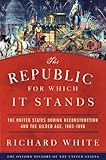The Republic for which it stands : the United States during Reconstruction and the Gilded Age, 1865-1896 / Richard White.
Material type: TextLanguage: English Series: The Oxford history of the United States | Oxford history of the United StatesPublisher: New York, NY : Oxford University Press, 2017Description: xx, 941 pages, 32 unnumbered pages of plates : illustrations (some color), maps ; 25 cmISBN:
TextLanguage: English Series: The Oxford history of the United States | Oxford history of the United StatesPublisher: New York, NY : Oxford University Press, 2017Description: xx, 941 pages, 32 unnumbered pages of plates : illustrations (some color), maps ; 25 cmISBN: - 9780199735815 (hardcover : alk. paper)
- 0199735816
- United States during Reconstruction and the Gilded Age, 1865-1896
- 973.8
- 002 E 668 W587r 2017
| Item type | Current library | Home library | Collection | Shelving location | Call number | Copy number | Status | Date due | Barcode |
|---|---|---|---|---|---|---|---|---|---|
 Libro
Libro
|
Biblioteca Juan Bosch | Biblioteca Juan Bosch | Recursos Regionales | Recursos Regionales (2do. Piso) | 002 E 668 W587r 2017 (Browse shelf(Opens below)) | 1 | Available | 00000119999 |
Includes bibliographical references (pages 873-901) and index.
Introduction -- Part I. Reconstructing the nation. Prologue : Mourning Lincoln -- In the wake of the War -- Radical reconstruction -- The greater reconstruction -- Home -- Gilded liberals -- Triumph of wage labor -- Panic -- Beginning a second century -- Part II. The quest for prosperity. Years of violence -- The party of prosperity -- People in motion -- Liberal orthodoxy and radical opinions -- Dying for progress -- The great upheaval -- Reform -- Westward the course of reform -- The center fails to hold -- The poetry of a pound of steel -- Part III. The crisis arrives. The other half -- Dystopian and utopian America -- The Great Depression -- Things fall apart -- An era ends -- Conclusion.
"During Reconstruction Northerners attempted to remake the United States in their own image. They would make incarnate the new world Republicans imagined at the end of the Civil War. That new world seemed possible because the Republican Party controlled the Union in 1865 as fully as any political party would ever control the country. Reconstruction would produce a nation built around free labor with a homogenous citizenry whose rights would be guaranteed by a newly empowered federal government. Black as well as white citizens would inhabit a largely Protestant country of independent producers. They never realized that dream. The government's attempts to implement this vision confronted significant obstacles. Southern whites successfully resisted, and Indians resisted with far less success. Freedpeople both grasped the opportunities that the Republican vision offered them and attempted to articulate their own version of republican America. The United States became a nation of immigrants, Catholic and Jewish as well as Protestant. New technologies transformed the economy, as Americans significantly shifted into wage workers instead of independent producers. Capitalism produced the very rich and the very poor. The Gilded Age thrived where Reconstruction failed, the template of American modernity. The era was full of paradoxes. Notoriously corrupt, it also formed a seedbed of reform. It spawned racial, religious, and social conflicts as deep as the country had seen to date, but a newly diverse nation emerged. The newest volume in the acclaimed Oxford History of the United States series, The Republic for Which It Stands offers a magisterial account of the Gilded Age's real legacy that lies buried beneath its capitalists of legend and its corrupt politicians."--Provided by publisher.


There are no comments on this title.